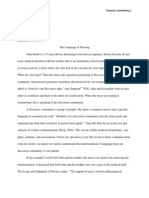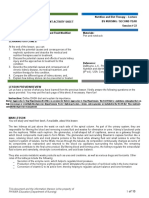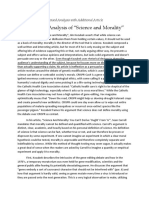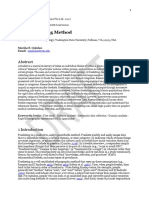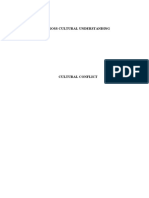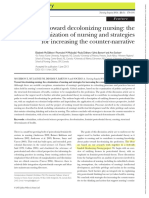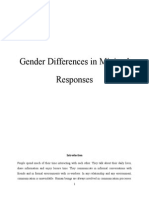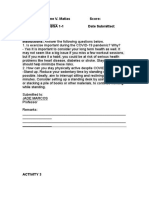Genre Analysis
Genre Analysis
Uploaded by
jrgoris9Copyright:
Available Formats
Genre Analysis
Genre Analysis
Uploaded by
jrgoris9Copyright
Available Formats
Share this document
Did you find this document useful?
Is this content inappropriate?
Copyright:
Available Formats
Genre Analysis
Genre Analysis
Uploaded by
jrgoris9Copyright:
Available Formats
Julio Goris Wolcott Spring 2013 MWF 9:30 am-10:20 am Genre Analysis Paper
The discourse community I have chosen to study and analyze is the physical therapy community. Through my research on a few articles Ive collected regarding the field of physical therapy, I noticed one key thing. The treatment of injury that hinders ones mobility is a situation that occurs frequently, and this discourse community is the rhetorical response to this occurrence. I find this to be the main purpose for the genre of physical therapy existing, and through some of the articles Ive selected I was able to notice some interesting trends and patterns of this emerging genre. The three articles I chose to analyze all came from a publication called PT in Motion. This periodical is written by both certified physical therapists, as well as freelance writers who interview several certified physical therapists about a certain topic they choose to write about, backed with the statistics to state their case. Due to this, one that is not actively involved in the physical therapy community or has no knowledge of the verbatim used may get lost at certain parts of an article. Thankfully, in all of these articles, when some unknown acronyms are introduced, the meaning is either placed in parentheses next to it, or it is explained in the following sentence. For example, in the article Making Waves With Aquatic Therapy by Lisa
Iannucci, on page 19, she uses a quote from a physical therapist named Allison Hoy, who works at The Walter Reed National Military Medical Center in Bethesda, Maryland. In the quote, Hoy says And we treat a special population of polytrauma patients (combat injuries in Afghanistan and Iraq) with amputations, limb salvage, and/or traumatic brain injury. Without indicating specifically what polytrauma patients are suffering from, one would be led to make an assumption of their own, which could end with someone either being misinformed or just missing the definition completely. The structure used was similar throughout all three, as the articles were divided into different section through the use of blue headings, making it easy to distinguish when you were moving into a different subject. Another trend I noticed while reading and sifting through the articles was the prevalence of advertisements throughout the articles. In the aforementioned Making Waves With Aquatic Therapy article by Iannucci, there were three different articles for products/services of use to professionals in the field on pages 19, 20, and 23. The same number of articles was found in an article called The Joint Manipulation Debate by Chris Hayhurst, on pages 31, 33, and 35. I believe these ads not only add some color to the articles to ease the eyes from all the reading, but it also helps the PTs and PTAs (physical therapists/ physical therapist assistants) by introducing them to products/services they may have not been aware of, and could help their practice or help them on a personal level. A few other visuals served as cover art for both the Making Waves With Aquatic Therapy and The Joint Manipulation Debate articles. Also, I observed their pattern of citations. When referencing a physical therapist, they would state their name, their credentials, and then where they practice physical therapy or where they teach it. In the Ethics in Practice: Were Being Used article by Nancy R Kirsch, PT, DPT, PhD and the Making Waves With Aquatic Therapy article by Lisa Iannucci, whenever they referenced a physical
therapist, they also provided a picture for them as well. All three articles had a references section at the end of the article, which serves as their works cited page. All in all, after the examination of these three articles, I believe the genre of physical therapy is designed to be one that can be easily understood by all and that makes strides and innovations readily accessible through using texts, such as the PT in Motion magazine. The explanation of phrases and different visuals make the articles informative and easy to read at the same time, while the in-text citations and references at the end make certain that everyone who was involved in the articles got their credit.
You might also like
- Action Research, The Riverbend Case ScenarioDocument8 pagesAction Research, The Riverbend Case Scenariogoodsamaritan.quillbotNo ratings yet
- Persuasive Speech Outline Daniel HanekDocument5 pagesPersuasive Speech Outline Daniel Hanekapi-384224589100% (1)
- Neuro ObsDocument1 pageNeuro ObsAristotle Javier100% (1)
- Checkers Speech Analysis PortfolioDocument4 pagesCheckers Speech Analysis PortfolioMichelle Rae100% (1)
- QSTR06319 Oliver John PDFDocument1 pageQSTR06319 Oliver John PDFJohn OliverNo ratings yet
- Immigrant Agency: Hmong American Movements and the Politics of Racialized IncorporationFrom EverandImmigrant Agency: Hmong American Movements and the Politics of Racialized IncorporationNo ratings yet
- Embraced by The NeedleDocument2 pagesEmbraced by The NeedleAdv Sandeep SinghNo ratings yet
- TEMPLATE For Annotated BibliographyDocument3 pagesTEMPLATE For Annotated Bibliographyabuntin2No ratings yet
- Charles R Lawrence/Derek Bob Essay Review On Freedom of SpeechDocument3 pagesCharles R Lawrence/Derek Bob Essay Review On Freedom of Speechjanell100% (2)
- Final Draft Ethos Pathos LogosDocument7 pagesFinal Draft Ethos Pathos Logosapi-288455590No ratings yet
- Examining The Mob MentalityDocument2 pagesExamining The Mob MentalitytrivendradonNo ratings yet
- Discourse CommunityDocument10 pagesDiscourse Communityapi-253794079No ratings yet
- Slo Reflection FinalDocument4 pagesSlo Reflection Finalapi-282368610No ratings yet
- Culture Emergent in OcupationDocument10 pagesCulture Emergent in OcupationTano TanitoNo ratings yet
- Hoffmann2018 Article TheElusiveNotionOfArgumentQualDocument28 pagesHoffmann2018 Article TheElusiveNotionOfArgumentQualIsabelNo ratings yet
- Chameleon EssayDocument3 pagesChameleon Essayapi-375035493No ratings yet
- The Great Dictator E28093 A Rhetorical AnalysisDocument7 pagesThe Great Dictator E28093 A Rhetorical AnalysisCallem McDougallNo ratings yet
- Nutrition and Diet Therapy: Principles and PracticeDocument11 pagesNutrition and Diet Therapy: Principles and PracticeCharisse Arriane BelasotoNo ratings yet
- Immediate Function and Esthetics in Implant DentistryDocument114 pagesImmediate Function and Esthetics in Implant Dentistryamirmaafi100% (1)
- Enema Instructional BookletDocument34 pagesEnema Instructional Bookletmumtean cosminNo ratings yet
- Cultural Diversity and ResilienceDocument22 pagesCultural Diversity and ResilienceJasmina Milojevic0% (1)
- Elite Discourse VanDocument33 pagesElite Discourse VanNasser AmmarNo ratings yet
- wp2 Draft 2Document6 pageswp2 Draft 2api-302403692No ratings yet
- Engl1010 Revised Rhetorical AnalysisDocument5 pagesEngl1010 Revised Rhetorical Analysisapi-494950991No ratings yet
- Hester Prynne and Monica Lewinsky - Deficit of EmpathyDocument7 pagesHester Prynne and Monica Lewinsky - Deficit of EmpathyBlake DeanNo ratings yet
- What Is NewsDocument2 pagesWhat Is NewsMushtaq MuhammadNo ratings yet
- The Freelisting Method: Marsha B. QuinlanDocument16 pagesThe Freelisting Method: Marsha B. QuinlanJHON MATEO GARCIA ROCHANo ratings yet
- Course Reflection EnglishDocument3 pagesCourse Reflection Englishapi-359156901100% (1)
- Research Methodology by Ashish Basnet.Document4 pagesResearch Methodology by Ashish Basnet.Learner84100% (1)
- Sample Speaking OutlineDocument2 pagesSample Speaking OutlineAtiqah NadirahNo ratings yet
- What Is A Technical Essay?: Abstract: Many Students Have To Write Technical Essays As Part of Their Coursework. Here WeDocument4 pagesWhat Is A Technical Essay?: Abstract: Many Students Have To Write Technical Essays As Part of Their Coursework. Here WeSaad MemonNo ratings yet
- Janks, H. (1997) - Critical DiscourseDocument15 pagesJanks, H. (1997) - Critical DiscourseSaadat Hussain Shahji PanjtaniNo ratings yet
- Annotated Bibliography: Abraham Rodriguez, Jr's "The Boy Without A Flag"Document3 pagesAnnotated Bibliography: Abraham Rodriguez, Jr's "The Boy Without A Flag"LINA PASSIONNo ratings yet
- Culture and Healthcare AssignmentDocument1 pageCulture and Healthcare AssignmentLakshya TripathiNo ratings yet
- Strömbäck (2005) - in Search of A Standard... (331-345)Document16 pagesStrömbäck (2005) - in Search of A Standard... (331-345)1DVSBSTRDNo ratings yet
- Reflection Teaching AdultsDocument6 pagesReflection Teaching AdultsphijuvNo ratings yet
- How To Write A Term Paper Uni DueDocument7 pagesHow To Write A Term Paper Uni Dueaflsigakf100% (1)
- Cross Cultural UnderstandingDocument12 pagesCross Cultural UnderstandingLily SinagaNo ratings yet
- Literature Review: IdeologyDocument11 pagesLiterature Review: IdeologyKyteNo ratings yet
- Annotated BibliographyDocument5 pagesAnnotated BibliographyElenaNo ratings yet
- Interpretive Essay CommentsDocument4 pagesInterpretive Essay CommentsAshton JordanNo ratings yet
- Cheris Kramarae EssayDocument6 pagesCheris Kramarae EssayNguyen Trung KienNo ratings yet
- Reflection #1Document4 pagesReflection #1GinnyNo ratings yet
- Term PaperDocument14 pagesTerm PaperMoodz TutanesNo ratings yet
- Discourse Community Paper-Rough DraftDocument8 pagesDiscourse Community Paper-Rough Draftcaseyparis11No ratings yet
- Chapter One Background of The Study 1.1Document52 pagesChapter One Background of The Study 1.1TAOHEEDNo ratings yet
- 15-04-2020-1586929736-8-Ijhss-5.Ijhss - The Communicativeness of Gender and Identity Formation The Dialectic of Women's RepresentationDocument8 pages15-04-2020-1586929736-8-Ijhss-5.Ijhss - The Communicativeness of Gender and Identity Formation The Dialectic of Women's Representationiaset123No ratings yet
- The Counterculture MovementDocument4 pagesThe Counterculture MovementBerenice BaezNo ratings yet
- AQCI Model - Reading FormDocument2 pagesAQCI Model - Reading FormRuxandra DiaconescuNo ratings yet
- New American Lecture Lesson Plan1Document3 pagesNew American Lecture Lesson Plan1api-231354055No ratings yet
- Anotated BibliographyDocument4 pagesAnotated BibliographyjordanboehningNo ratings yet
- Sociology 30 - Intro Culture RulesDocument15 pagesSociology 30 - Intro Culture Rulesapi-203814269No ratings yet
- Metonymic Friends and Foes Metaphor andDocument9 pagesMetonymic Friends and Foes Metaphor anddaniela1956No ratings yet
- News Framing and The Public Opinion - A Mediational Analysis of Framing Effects On Political AttitudesDocument26 pagesNews Framing and The Public Opinion - A Mediational Analysis of Framing Effects On Political AttitudesThijs SmetNo ratings yet
- Chavez EssayDocument2 pagesChavez Essayapi-306702921100% (1)
- Rhetorical EssayDocument7 pagesRhetorical Essaycmtodd13No ratings yet
- CJ 1010 - Critical Thinking AssignmentDocument10 pagesCJ 1010 - Critical Thinking Assignmentapi-453193984No ratings yet
- Becker, Howard. 1953. Becoming A Marihuana User.Document9 pagesBecker, Howard. 1953. Becoming A Marihuana User.rusudanzazadze7100% (1)
- APA in Text CitationsDocument5 pagesAPA in Text CitationsEmil MăSeacă100% (1)
- McGibbon - Toward Decolonizing Nursing The Colonization of Nursing and Strategies For IncreasingDocument13 pagesMcGibbon - Toward Decolonizing Nursing The Colonization of Nursing and Strategies For IncreasingNavid BagheriNo ratings yet
- Media TheoristsDocument4 pagesMedia TheoristsMrsMellish100% (1)
- Gender Differences in Minimal ResponsesDocument9 pagesGender Differences in Minimal ResponsesManu EllaNo ratings yet
- Codes of Gender Study GuideDocument15 pagesCodes of Gender Study Guidezinkblink100% (1)
- Stasis Theory in Academic Writing - Student Slides 3Document11 pagesStasis Theory in Academic Writing - Student Slides 3api-490608937No ratings yet
- A Critical Analysis of the Efficacy of Law as a Tool to Achieve Gender EqualityFrom EverandA Critical Analysis of the Efficacy of Law as a Tool to Achieve Gender EqualityNo ratings yet
- Notes:: Oet Case Notes (Nursing)Document2 pagesNotes:: Oet Case Notes (Nursing)Ligy GeorgeNo ratings yet
- T 1234029783 11845985 Nursing Crib Com Nursing Care Plan Dengue FeverDocument2 pagesT 1234029783 11845985 Nursing Crib Com Nursing Care Plan Dengue Feversamantha cortezNo ratings yet
- Epulis PathologyDocument5 pagesEpulis PathologyStefany FanyNo ratings yet
- Name: Donna Jane V. Matias Score: - Course/Section: BSA 1-1 Date Submitted: - Activity 1 Instructions: Answer The Following Questions BelowDocument4 pagesName: Donna Jane V. Matias Score: - Course/Section: BSA 1-1 Date Submitted: - Activity 1 Instructions: Answer The Following Questions BelowJoseph kasingNo ratings yet
- SuctioningDocument13 pagesSuctioningAmanda ScarletNo ratings yet
- The Doctor Will Sue You NowDocument11 pagesThe Doctor Will Sue You NowMateja MijačevićNo ratings yet
- Alumni Interview With James JanuchDocument2 pagesAlumni Interview With James Januchapi-535598475No ratings yet
- Agenda at A Glance PDF 1012Document4 pagesAgenda at A Glance PDF 1012Amit MalviyaNo ratings yet
- Water and Electrolyte Balance Case StudyDocument3 pagesWater and Electrolyte Balance Case Studyzamadula100% (3)
- Rockwood. Theou 2020. Clinical Frailty ScoreDocument6 pagesRockwood. Theou 2020. Clinical Frailty ScoreTomas Andres Bahamondes CordovezNo ratings yet
- Jurnal 8Document7 pagesJurnal 8Fatma BaagilNo ratings yet
- 360-Article Text-929-1-10-20210507Document6 pages360-Article Text-929-1-10-20210507Ranindya PutriNo ratings yet
- Surgery AssignmentDocument10 pagesSurgery AssignmentDaniella DukmakNo ratings yet
- High Performance in Hospital Management PDFDocument232 pagesHigh Performance in Hospital Management PDFZaid R100% (1)
- 03 Introduction To Acupuncture & AcupressureDocument14 pages03 Introduction To Acupuncture & AcupressureDeepak MohandassNo ratings yet
- Congenital GlaucomaDocument27 pagesCongenital Glaucomaanon_373532435No ratings yet
- Sandra Peterson Case NotesDocument3 pagesSandra Peterson Case NotesOana Maria Grigore0% (1)
- NCP GrandcaseDocument5 pagesNCP GrandcaseSaima BataloNo ratings yet
- Pcos Purposal 1Document33 pagesPcos Purposal 1sushma shrestha0% (2)
- 2 Complications of Pulmonary TB PDFDocument18 pages2 Complications of Pulmonary TB PDFGuling SetiawanNo ratings yet
- Epilepsy 2024Document39 pagesEpilepsy 2024zainabNo ratings yet
- CertificateDocument1 pageCertificateAnkit DubeyNo ratings yet
- Junevile DM Kel. 4Document7 pagesJunevile DM Kel. 4suci arleniaNo ratings yet
- 13 IMPLANT SUPPORTED FIXED PROSTHESESmic PDFDocument52 pages13 IMPLANT SUPPORTED FIXED PROSTHESESmic PDFManaila GeorgianNo ratings yet
- Posttraumatic Stress Disorder Epidemiology, Pathophysiology, Clinical Manifestations, and DiagnosisDocument9 pagesPosttraumatic Stress Disorder Epidemiology, Pathophysiology, Clinical Manifestations, and Diagnosisisa_horejsNo ratings yet











